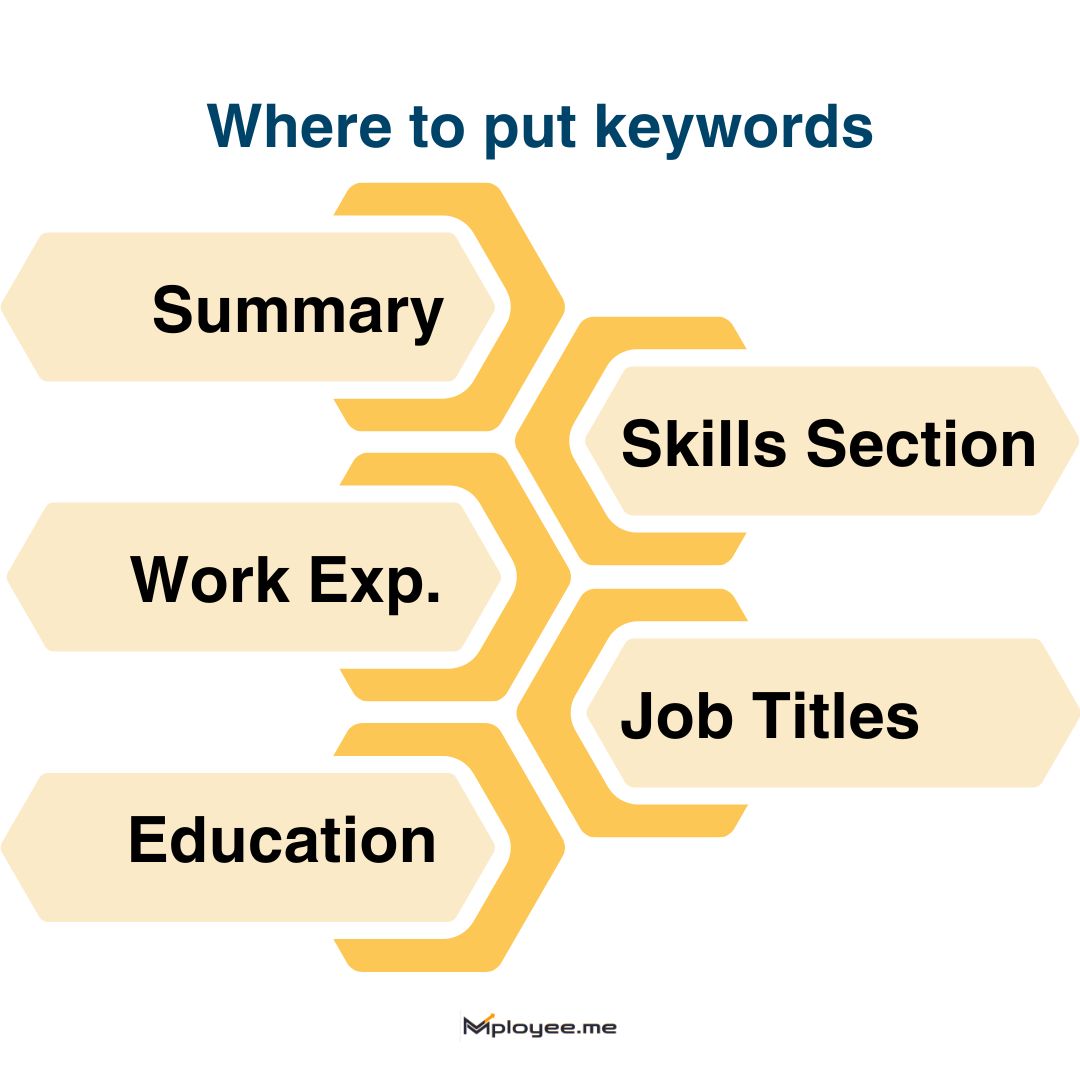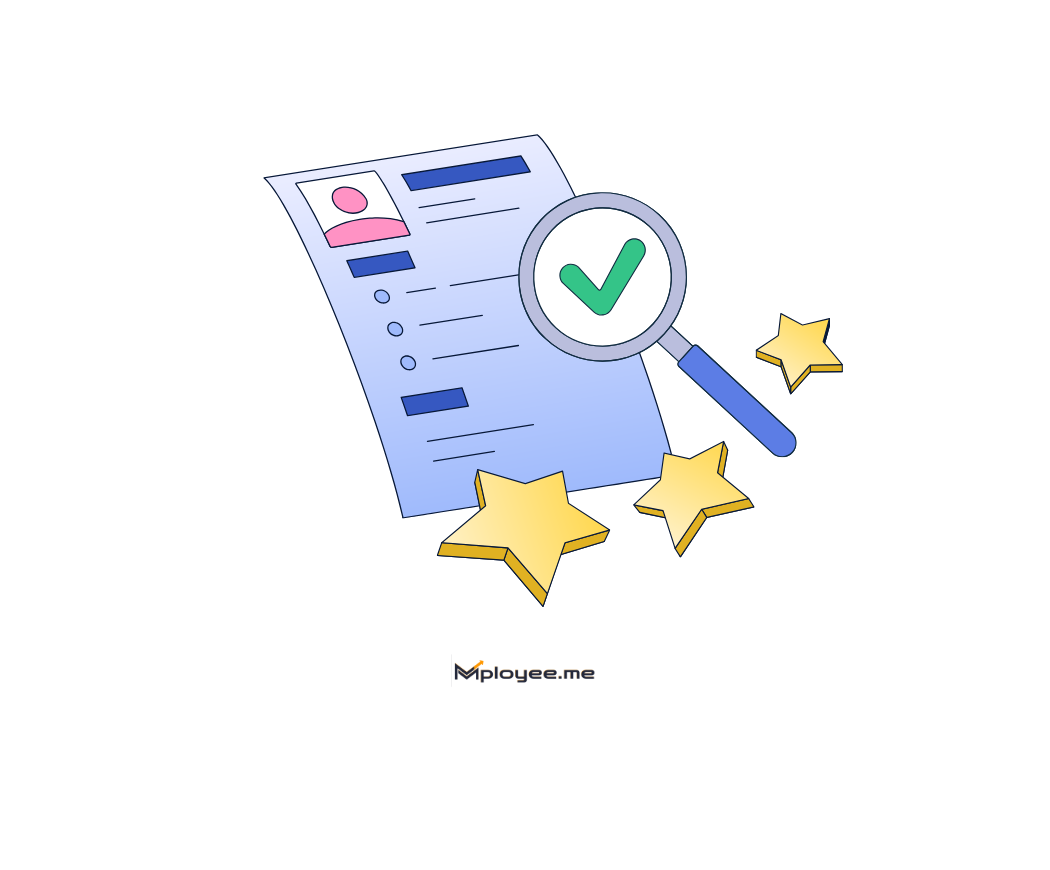
We'll cover
How to Add Keywords in a Resume
Written By Editorial Team

Including targeted keywords in your resume is very important for passing Applicant Tracking Systems (ATS) and catching the recruiter's eye. These ATS resume keywords reflect the skills, qualifications, and experience the employer is looking for. Strategically placing them in each section ensures that your resume not only comes up on searches but also matches the requirements needed.This is how you do it:
We'll cover:
1). Keywords for Professional Summary:
Your professional summary comes at the beginning of your resume, so it's the first thing a reader and an ATS will see. This is where you'll include the most critical, high-priority resume keywords from the job description.
- Begin with the job title precisely as presented in the listing.
- Add 2–3 hard skills or specializations the position highlights.
- Make it tight 2–3 lines but rich with pertinent content.
2). Keywords for Skills Section:
Your skills section should be your ATS magnet. ATS programs tend to look to this section for exact matches prior to reviewing the rest of your resume.
Best Practices:
- Use the same wording as in the job advertisement, if they use "content management systems," don't abbreviate "CMS" unless you also use the full phrase elsewhere.
- Organize skills in a logical manner (technical, analytical, leadership).
- Combine hard skills (e.g., SQL, JavaScript) with job-specific soft skills (e.g., stakeholder communication, team leadership).
- Technical Skills: SQL, Tableau, Python, Google Analytics
- Project Management: Agile, Scrum, Jira, Sprint Planning
3). Keywords for Work Experience:
This is where keywords become proof. Instead of just listing skills, embed them in results oriented bullet points.
- Start each bullet with an action verb.
- Include a keyword naturally.
- End with a measurable result if possible.
By making this happen, your keywords are linked to concrete results, and they are more convincing.
- Implemented SEO optimization strategies that increased organic search traffic by 45% within 6 months.
- Directed an Agile project team of 8 members to complete a SaaS platform before deadline, enhancing client onboarding efficiency by 30%.
- Optimized Google Ads campaigns, boosting conversion rates by 25% while reducing ad spend by 15%.
- Collaborated cross-functionally to design and execute monthly email marketing campaigns, resulting in a 20% increase in open rates.
4). Keywords for Job Title:
Both recruiters and ATS heavily depend on job titles to assess relevance.
- If your previous title aligns very closely with the job you're applying for, then use it word for word as appearing in the posting.
- If it's different but the job was more or less the same.
5). Keywords for Education and Certifications:
Education and certifications might not be the first section an ATS reads, but including exact keyword wording here is still important—particularly if specific degrees or credentials are necessary.
- Always include the certification name as it appears in the listing.
- If there are standard abbreviations, include both to increase searchability.
- Project Management Professional (PMP)
- Certified Scrum Master (CSM)
- Google Analytics Individual Qualification (GAIQ)
- PMP
- CSM
- GAIQ
How to add keywords in your resume ?
1). Analyze the job description:
The key to keyword selection is knowing what the employer really wants. Read the job posting carefully and underline recurring phrases of particularly job titles, technical skills, tools, certifications, and experience.
- Give special attention to repeated hard skills (such as "JavaScript," "budget forecasting") and soft skills ("team leadership," "client relations").
- Scan several listings for the same type of job. Trends you notice across them are high value keywords.
- Keep in mind: Exact spellings count. If the job description mentions "content management systems," use that entire phrase not simply "CMS."
Consider this similar to stockpiling your keyword bank prior to writing your resume.
2). Keyword Placement:
Discovering the right ATS resume keywords is just half the fight, knowing precisely where to position them within your resume is what makes them effective. The objective is to maximize the odds that both an ATS and a hiring manager can instantly recognize you for the job. Positioning is what makes things visible, relevant, and impactful.
3). Pick Relevant Keywords:
Now that you have your keywords for CV, you must determine which to highlight most and how to prevent your resume from becoming repetitive.
Relevance:
Not all keywords are worth using; only select those that most closely map to the core duties of the role.
(b) Use Synonyms:
If the job advertisement mentions "software development," you could also use "application development" or "programming" in other areas to capture different variations.
(c) Mix Keywords:
Combine hard skills (e.g., "Python," "budget forecasting") and soft skills ("team leadership," "negotiation") to appeal to both ATS filters and human discretion.
4). Avoid Keyword Stuffing:
Whereas keywords for resume are vital, stuffing your resume can damage readability and credibility.
(a) Be Natural
Put words together in complete, logical phrases rather than forcing your way with cumbersome terms.
For instance, rather than "Responsible for project management agile scrum," use:
"Managed projects utilizing Agile Scrum methodology, reducing delivery timelines by 15%."
(b) Provide Context:
Support keywords with examples, accomplishments, and statistics to demonstrate you actually possess the skill. This not only meets the ATS but persuades the recruiter.
5). Modify Each Application:
Keyword optimization is not something you do once.
(a) Customize:
Rearrange your professional summary, modify your skills, and adapt bullet points for every job to include its respective keywords.
(b) Refresh:
Maintain a “master resume” with all your roles, skills, and achievements. Pull from it when applying, adding or swapping keywords as needed.

The Difference Between Hard and Soft Skill Keywords
When optimizing your resume, it’s important to recognize that not all ATS resume keywords are the same. Broadly speaking, they fall into two categories: hard skills and soft skills, both play a unique role in making your application stand out.
Hard skill terms are precise, quantifiable skills or technical skills. The term "Python," "financial modeling," "SEO optimization," and "project scheduling" would be examples of these. They are typically non-compromisable for a position and can easily be checked based on your experience or credentials. ATS will strongly consider these since they are a direct reflection of capability.
Soft skill terms identify personal qualities and interpersonal skills, such as "team collaboration," "flexibility," or "leadership." Although more difficult to quantify, they are essential for cultural alignment and are usually mentioned directly in a job posting.
The most effective resume combines both. For instance:
"Directed cross-functional groups (soft skill) to deploy data analytics dashboards (hard skill) that delivered a 20% gain in reporting effectiveness."
This strategy not only guarantees you're targeting the right keywords but also proves you can translate your skills into real world applications, something ATS and human recruiters alike appreciate.
Why Keywords for Resume Are Also Important for Human Recruiters ?
While a lot of the discussion about keywords for CV centers on Applicant Tracking Systems (ATS), it's tempting to overlook that your resume ultimately will be read by a human recruiter. Keywords do more than simply enable you to beat the bot screens, they also serve as instant visual reminders that confirm to the recruiter you possess the precise skills and experience they desire.
Hiring managers will scan resumes within seconds, searching for familiar language from the job posting. If your resume reflects those words such as "data visualization," "process improvement," or "stakeholder management", the recruiter's eyes are drawn to them automatically, and they tick you mentally as a strong candidate.
Furthermore, keywords also indirectly influence the perception of your professional status. For instance, a job applicant who continually employs words such as "strategic planning," "budget management," and "cross-functional leadership" portrays an image of a senior-level professional with leadership skills.
The trick is balance: you do not only need ATS friendly language, but readability for human consumption is just as crucial. Putting keywords within context rich sentences instead of lists keeps your resume engaging without sacrificing the language that the recruiter is seeking. That way, keywords serve as a bridge that translates into something that connects you with algorithms and humans alike.
Final Takeaways
- ATS terms are essentially the “search engine keywords” for your career.
- Always put key skills in a clear, scannable section but remember to back them up in your experience.
- Formatting should prioritize simplicity and consistency for both humans and ATS.
- PDFs are generally fine for modern ATS, but always check the employer’s instructions.
- Find keywords for resume by studying job descriptions, industry jargon, and competitor postings.
- Add skills to an ATS resume using exact wording and multiple placements.
- In interviews, keywords help you speak the employer’s language and be more memorable.
- For employees, keywords aren’t just for resumes, they’re a career long tool for visibility and advancement.
1. What are ATS terms?
ATS terms are the keywords, phrases, and criteria that an Applicant Tracking System (ATS) uses to screen resumes. Employers load their ATS software to search for industry related language, job titles, qualifications, and skills that fit the job description.
For instance, if an employer is looking to hire for a "Digital Marketing Specialist" role, the ATS may look for keywords such as "SEO," "Google Analytics," "content strategy," and "PPC advertising." These are usually taken directly from the job
description.
If your resume lacks sufficient of these ATS keywords or has totally different language then your application may be ranked lower or filtered out prior to when a human recruiter ever lays eyes on it.
2. How to list key skills on a resume ?
3. How do I lay out my resume ?
4. Can ATS read PDF ?
5. How to find keywords for CV
6. How to add skills in ATS resume?
7. What do keywords do in an interview ?
8. What are keywords for employees ?

Got Your Answer ?
Learn this in 30 Seconds 👇
Career Blogs
Our career blog is your go-to resource for insightful advice, practical tips, and the latest trends in the job market.

Office Address: Room No 305, IIT ROPAR-TBIF, Top Floor (East Wing), M.Visvesvaraya, Rupnagar PB, 140001
- Free Online Resume Review
- Check Resume Score
- Job Description Keyword Finder
- Resume Shortlisting Software
- Resume Scanner for Jobs
- Find jobs that match with resume
- Job matching platform
- Resume job matching
- Job suggestion
- Best sites to find jobs
- Free ats resume scanner
- Auto apply for job
- Full Time Jobs
- I Need a Job
- Information Technology Jobs
Can't Find Something? Get in Touch.
©2025 Padhakku Peek A Book Pvt Ltd (Mployee.me)






